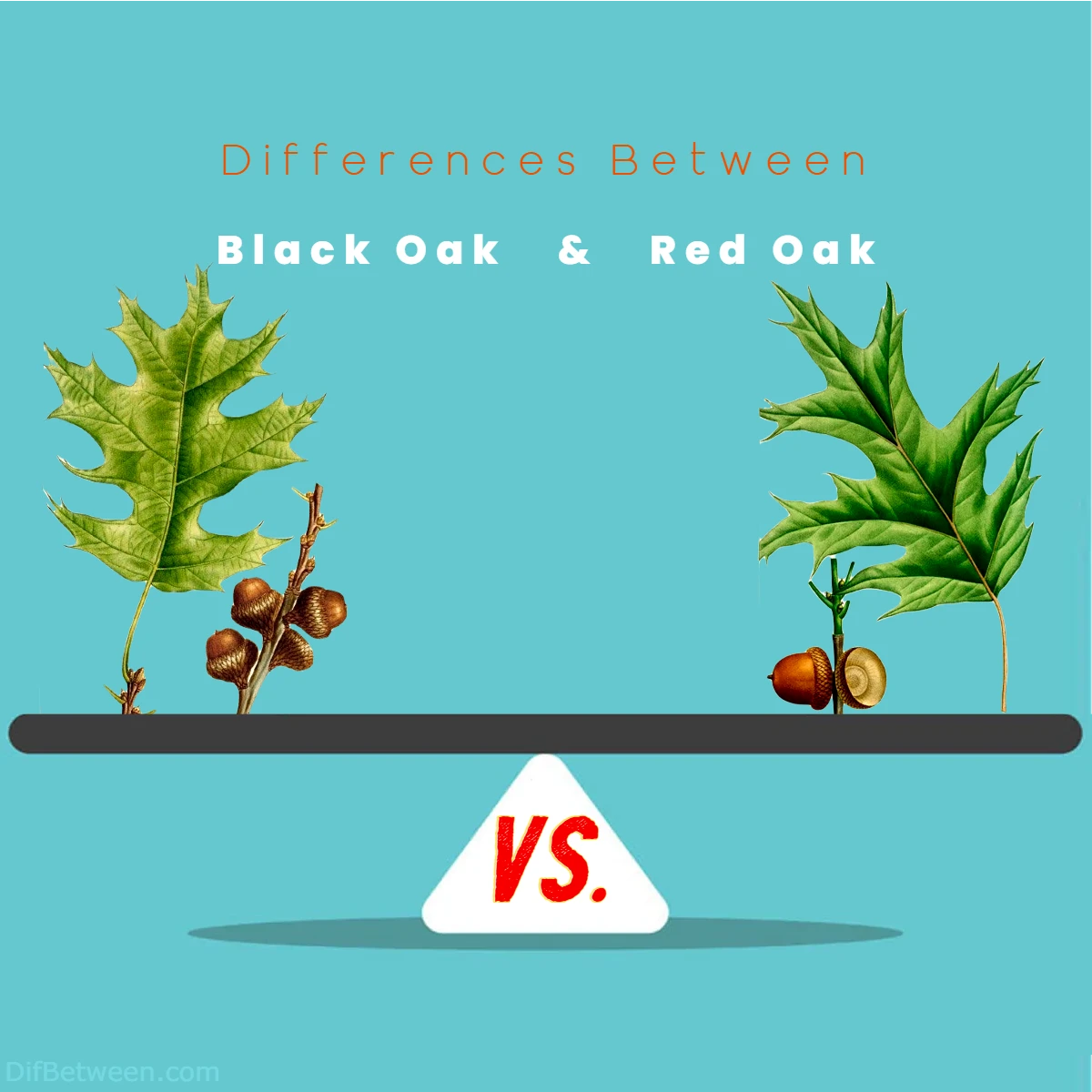
| Characteristic | Black Oak (Quercus velutina) | Red Oak (Quercus rubra) |
|---|---|---|
| Bark Appearance | Dark, rugged, matures into deep furrows | Initially smooth, matures into rough, diamond-patterned ridges |
| Leaf Characteristics | 5-9 deeply-lobed leaflets | 7-11 lobed leaflets |
| Leaf Size | 5-10 inches long, 3-6 inches wide | 6-9 inches long, 4-7 inches wide |
| Fall Foliage Colors | Brilliant warm colors, reds and oranges | Stunning range of red hues |
| Acorn Production | Medium-sized acorns, matures in 2 years | Larger acorns, matures in 2 years |
| Acorn Cycle | Consistent production | Variable production cycle |
| Wood Color | Warm reddish-brown | Light pinkish hue |
| Wood Grain | Coarse-grained | Prominent grain |
| Habitat Preference | Dry uplands, rocky slopes | Diverse soils, mixed forests |
| Size | 60-80 feet tall, 40-60 feet spread | 60-75 feet tall, 45-50 feet spread |
| Growth Rate | Moderately fast | Moderately fast |
| Cultural Significance | Symbol of endurance and resilience | Admirable traits in various cultures |
| Wildlife Habitat | Valuable food source, nesting sites | Abundant food source, nesting spots |
| Conservation Concerns | Habitat loss, invasive species | Pest and disease susceptibility |
| Landscaping Use | Grandeur in larger landscapes | Captivating presence in various spaces |
| Woodworking Use | Strong, durable wood for various projects | Versatile wood for different creations |
Nature, with its infinite diversity, has blessed us with these two splendid members of the oak family, both belonging to the Quercus genus. Picture the towering canopies and the textured bark, each characteristic a brushstroke in the masterpiece of our natural world. The leaves, a canvas of intricate patterns, transition into a symphony of colors as the seasons change. Acorns, nature’s treasures, cascade from the branches, enriching the lives of wildlife that rely on these gifts. But beyond their appearances lie stories of resilience, cultural significance, and ecological roles.
Differences Between Black Oak and Red Oak
The main differences between Black Oak and Red Oak lie in their distinct bark appearances, leaf characteristics, acorn production, wood attributes, and preferred habitats. Black Oak features dark, rugged bark that matures into deep furrows, while Red Oak’s bark starts smooth and develops into rough, diamond-patterned ridges. Black Oak’s leaves have 5-9 deeply-lobed leaflets, while Red Oak’s leaves showcase 7-11 lobed leaflets. Acorn production varies, with Black Oak producing medium-sized acorns that mature consistently, whereas Red Oak’s larger acorns have an irregular production cycle. The wood of Black Oak is coarse-grained with a warm reddish-brown color, ideal for woodworking, while Red Oak’s wood boasts a prominent grain and light pinkish hue. Their preferred habitats also differ, with Black Oak thriving in dry uplands and rocky slopes, and Red Oak adapting to a range of soils in mixed forests.
1. Appearance and Bark
Black Oak: Black Oak (Quercus velutina) boasts a striking appearance that captures the eye. The leaves of this tree typically have 5 to 9 deeply-lobed bristle-tipped leaflets, creating a beautiful, textured canopy. One of the defining features is its dark, rugged bark that matures into deep furrows and rough ridges. As the tree ages, the bark becomes darker and more pronounced, adding to its charm.
In terms of size, Black Oaks are known to be sizable trees, often reaching heights of 60 to 80 feet (18 to 24 meters) with a spread of 40 to 60 feet (12 to 18 meters). Their growth rate is moderately fast, making them relatively quick to establish in the landscape.
Red Oak: Conversely, Red Oak (Quercus rubra) showcases its own unique charm. Its leaves typically have 7 to 11 lobes, creating a more delicate and intricate appearance compared to the Black Oak. The bark of a young Red Oak is notably smooth, with a light grayish hue. However, as the tree matures, the bark transforms into dark, rough ridges that exhibit a diamond-like pattern, setting it apart from the Black Oak.
In terms of size, Red Oaks are similar to Black Oaks, often growing to heights of 60 to 75 feet (18 to 23 meters) and spreading 45 to 50 feet (14 to 15 meters). This species is also known for its moderate growth rate.
2. Leaf Characteristics
Black Oak: The leaves of Black Oak are a true testament to nature’s artistry. They are typically 5 to 10 inches long and 3 to 6 inches wide, showcasing deep green hues during the growing season. Come autumn, these leaves transform into a brilliant display of warm colors, ranging from deep reds to rich oranges, making it a favorite for fall foliage enthusiasts.
Red Oak: The leaves of Red Oak are equally captivating. They are larger than those of the Black Oak, measuring about 6 to 9 inches long and 4 to 7 inches wide. During spring and summer, they flaunt a vibrant green color, which later evolves into a breathtaking range of red tones in the fall. This transformation has earned the Red Oak a reputation as one of the most stunning trees to grace the autumn landscape.
3. Acorn Production
Black Oak: When it comes to acorn production, Black Oaks tend to be relatively generous. Their acorns are medium-sized and mature in their second year. These acorns serve as a valuable food source for various wildlife species, contributing to the ecosystem’s vitality.
Red Oak: Red Oaks, on the other hand, are known for their irregular acorn production cycles. Some years may see a bountiful harvest of acorns, while others may experience limited production. These acorns are also larger than those of the Black Oak and usually take two years to mature. Just like the Black Oak’s acorns, they play a crucial role in supporting wildlife populations.
4. Wood Characteristics
Black Oak: The wood of the Black Oak is highly regarded for its strength and durability. It is known to be heavy, hard, and coarse-grained, making it an excellent choice for various woodworking applications. The wood’s distinct grain pattern and warm reddish-brown color contribute to its popularity in crafting furniture, flooring, and cabinets.
Red Oak: Similarly, the wood of the Red Oak is prized for its strength and versatility. It is slightly lighter in color compared to Black Oak, featuring a more pinkish hue. The wood’s prominent grain and resistance to wear make it a favorite for flooring, cabinetry, and other decorative woodwork.
5. Habitat and Distribution
Black Oak: Black Oaks thrive in a variety of habitats, ranging from dry uplands to rocky slopes. They are commonly found in eastern and central North America, stretching from New England down to parts of Florida and westward to the Great Plains. Their adaptability to different soil types and conditions makes them a hardy choice for landscapes.
Red Oak: Red Oaks are widespread in the eastern and central regions of North America as well. They flourish in a diverse range of soils, from acidic to neutral. You can spot them from the Maritimes of Canada down to Georgia and as far west as parts of Texas. Their ability to tolerate varying moisture levels contributes to their prevalence in mixed forests.
6. Ecosystem Role and Benefits
Black Oak: Black Oaks play a crucial role in their ecosystems. They provide habitat and food for various wildlife species, including birds, mammals, and insects. The acorns they produce serve as a vital food source for animals, helping to sustain local biodiversity. Additionally, their expansive canopies offer shade and contribute to temperature regulation in their environments.
Red Oak: Red Oaks also contribute significantly to their ecosystems. The acorns they produce are eagerly consumed by wildlife, supporting the food web. The shade they offer and their capacity to sequester carbon make them important components in the fight against climate change.
7. Cultural and Historical Significance
Black Oak: Black Oaks have held cultural significance for various Indigenous communities and have been used for medicinal, ceremonial, and practical purposes. Some tribes utilized the inner bark for its medicinal properties, while others crafted baskets and dyes from its materials. The Black Oak’s stately presence in landscapes also made it a symbol of endurance and resilience.
Red Oak: Similarly, Red Oaks have played vital roles in the traditions of Indigenous peoples. The bark of the Red Oak was often employed in traditional medicine, and its wood was used for crafting tools, baskets, and even canoes. The Red Oak’s longevity and strength were admired traits that carried symbolic meanings in different cultures.
8. Wildlife Habitat and Conservation
Black Oak: The Black Oak’s extensive branching and dense canopy provide excellent nesting sites for various bird species, including woodpeckers, owls, and hawks. These trees also support a diversity of insects, which in turn feed many birds. Conservation efforts often involve promoting the growth of Black Oaks to enhance wildlife habitat and contribute to local biodiversity.
Red Oak: Red Oaks also contribute significantly to wildlife habitat. Their large and sturdy branches offer nesting spots for birds, and their acorns sustain numerous animals through the seasons. Conservation initiatives frequently include Red Oaks due to their ecological importance and the benefits they bring to the local ecosystem.
9. Challenges and Threats
Black Oak: Black Oaks face challenges such as habitat loss due to urban development and invasive species that can outcompete native vegetation. Climate change also poses a threat, as the trees may face increased stress from changing temperature and precipitation patterns. Conservation efforts aim to protect and restore Black Oak populations to maintain their ecological value.
Red Oak: Red Oaks confront similar challenges, including habitat loss and competition from non-native species. The increasing frequency of pests and diseases, such as the invasive oak wilt disease, poses a significant threat to Red Oak populations. Conservation strategies include disease management and promoting diverse forest ecosystems.
10. Landscaping and Urban Use
Black Oak: Due to their impressive size and unique bark, Black Oaks are often sought after for landscaping purposes. They can provide shade, beauty, and habitat value to urban and suburban environments. However, their large size may not be suitable for all spaces, and their potential for dropping acorns and leaves should be considered.
Red Oak: Red Oaks are also popular choices for landscaping due to their vibrant fall foliage and overall grandeur. They add aesthetic value to parks, streets, and gardens. Like the Black Oak, their large size requires careful consideration when choosing them for urban planting, considering factors such as space and potential maintenance requirements.
Black Oak or Red Oak: Which One is Right Choose for You?
As you embark on the journey of selecting the perfect oak tree to grace your landscape or woodworking project, the decision between Black Oak and Red Oak may seem daunting. Fear not! We’re here to help you navigate this choice by considering your preferences, needs, and the unique traits of each tree. Let’s delve into some key factors that can guide you toward the right choice.
Consider Your Landscape and Space
Black Oak: If you’re blessed with a spacious yard or property, the majestic Black Oak could be an excellent fit. Its robust size and spreading canopy create an impressive presence, adding a touch of grandeur to larger landscapes. Keep in mind that Black Oaks are best suited for areas where their expansive growth won’t be constrained, allowing them to flourish naturally.
Red Oak: For those with a bit less space, the Red Oak offers a captivating compromise. While still substantial in size, Red Oaks generally have a slightly smaller spread compared to Black Oaks. This makes them more adaptable to various landscape sizes, from suburban backyards to urban green spaces.
Appreciate the Aesthetics
Black Oak: If you’re drawn to the rugged, textured look of dark bark and deeply-lobed leaves, the Black Oak’s aesthetic might resonate with you. Its commanding presence and unique bark characteristics make it a standout feature in any landscape. Additionally, the rich fall foliage of the Black Oak adds a spectacular burst of color to your surroundings.
Red Oak: On the other hand, if you’re captivated by intricate leaf patterns and a distinct diamond-like bark, the Red Oak’s visual appeal might be more to your liking. The Red Oak’s stunning display of autumn hues further enhances its charm, turning your landscape into a vibrant canvas.
Consider Wildlife and Ecosystem Benefits
Black Oak: If you’re passionate about supporting local wildlife and biodiversity, both Black Oak and Red Oak offer valuable contributions. Black Oaks, with their medium-sized acorns and dense canopy, can provide ample food and shelter for various creatures. Their larger size can attract birds and mammals seeking nesting sites.
Red Oak: Similarly, Red Oaks attract wildlife with their larger acorns and substantial branches. By incorporating either tree into your landscape, you’re not only adding visual appeal but also providing essential resources for birds, squirrels, and other animals.
Think About Woodworking Projects
Black Oak: If you’re a woodworking enthusiast looking to craft furniture, cabinetry, or flooring, the Black Oak’s dense, coarse-grained wood is an excellent choice. Its warm reddish-brown color and distinctive grain pattern can add character to your creations, making them truly one-of-a-kind.
Red Oak: Likewise, if you’re considering woodworking projects, the Red Oak’s versatile wood is equally appealing. Its prominent grain and light pinkish hue lend themselves well to a variety of projects, from intricate carvings to sturdy furniture pieces.
Climate and Maintenance Considerations
Black Oak: When choosing between these oaks, consider your local climate and maintenance capacity. Black Oaks are adaptable to various soil types and conditions, making them hardy choices. However, their acorns and leaves may require regular cleanup, particularly in more populated areas.
Red Oak: Red Oaks are also adaptable and well-suited to diverse climates. They offer a slightly smaller footprint in terms of canopy size, which might make them more manageable for urban landscapes with limited space.
In Summary:
- Choose the Black Oak if you have ample space, appreciate rugged bark and deep fall foliage, and want to make a bold statement in your landscape. Its wood is perfect for woodworking projects that require durability and character.
- Opt for the Red Oak if you have a slightly smaller space, admire intricate leaf patterns and diamond-like bark, and want to support wildlife while enjoying stunning autumn colors. Its versatile wood can suit a wide range of woodworking endeavors.
Ultimately, the choice between Black Oak and Red Oak boils down to your personal preferences, space availability, and the impact you wish to make on your environment. Both trees offer unique beauty and ecological benefits, ensuring that whichever you choose, you’re enriching your surroundings and connecting with the natural world in a meaningful way.
FAQs
Black Oak has dark, rugged bark that matures into deep furrows, while Red Oak starts with smooth bark that develops into rough, diamond-patterned ridges. Black Oak’s leaves have 5-9 deeply-lobed leaflets, while Red Oak’s leaves showcase 7-11 lobed leaflets.
Black Oak produces medium-sized acorns that mature consistently, while Red Oak’s larger acorns have an irregular production cycle, resulting in varying years of abundance.
The wood of Black Oak is coarse-grained with a warm reddish-brown color, making it a favorite for woodworking. Red Oak’s wood has a light pinkish hue and a prominent grain, also ideal for various woodworking projects.
Certainly. Black Oak thrives in dry uplands and rocky slopes, while Red Oak adapts to a variety of soils and is prevalent in mixed forests.
Both trees provide habitat and food sources for various wildlife species. Their acorns and branching structures attract birds, mammals, and insects, supporting local biodiversity.
Choosing between Black Oak and Red Oak for landscaping depends on your available space. Black Oak’s larger size makes it suitable for spacious landscapes, while Red Oak’s slightly smaller spread accommodates a broader range of spaces.
Both Black Oak and Red Oak hold cultural importance for Indigenous communities. They have been used for traditional medicine, ceremonies, and practical purposes, representing endurance and admired traits.
Yes, both species face challenges such as habitat loss and competition from invasive species. Red Oaks are also susceptible to pests and diseases like oak wilt, warranting conservation efforts to protect their populations.
The wood of Black Oak is favored for its durability and distinct grain, making it suitable for furniture, flooring, and cabinetry. Red Oak’s wood, with its versatile grain and color, is also popular for a wide range of woodworking creations.
Consider factors like available space, aesthetic preferences, intended use, and local climate. Each species has its unique traits that can complement your vision and goals.
Read More:
Contents





